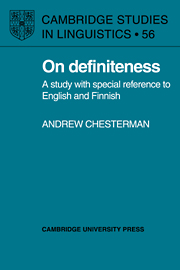Book contents
- Frontmatter
- Contents
- Acknowledgements
- 1 Introduction
- 2 English articles: the research traditions
- 3 English article usage
- 4 A unified description of the English articles
- 5 Finnish: no articles
- 6 Finnish spesies
- 7 The status of definiteness in Finnish
- 8 English and Finnish contrasted
- 9 Wider perspectives
- References
- Author index
- Subject index
2 - English articles: the research traditions
Published online by Cambridge University Press: 18 September 2009
- Frontmatter
- Contents
- Acknowledgements
- 1 Introduction
- 2 English articles: the research traditions
- 3 English article usage
- 4 A unified description of the English articles
- 5 Finnish: no articles
- 6 Finnish spesies
- 7 The status of definiteness in Finnish
- 8 English and Finnish contrasted
- 9 Wider perspectives
- References
- Author index
- Subject index
Summary
Background
This chapter brings together a wide range of research trends on the articles. In the course of the discussion a number of questions will be raised that do not yet seem to have been satisfactorily resolved, such as the following: Is definiteness a simple binary opposition? What do ‘definite’ and ‘indefinite’ mean? How many articles are there? What does ‘no article’ mean? What is the individual meaning of each article? The underlying theme of the chapter is that these questions can only be answered adequately within a theory of the articles that will incorporate insights from several research traditions into a coherent whole, for each of the existing descriptions is in some way or other too restricted.
In very general terms, modern research into the English articles has tended to fall into one of three broad types. One approach, starting with Russell (1905), centres on the meaning of definiteness and the expression of this meaning throughout the grammar. A second approach is illustrated by studies in the generative tradition: here the concern is with the correct derivation of the articles, the rules that will generate the correct article in a given context. The third approach has been to start with the articles themselves, their distribution and meaning, and also with the question of which forms should actually count as articles.
- Type
- Chapter
- Information
- On DefinitenessA Study with Special Reference to English and Finnish, pp. 10 - 40Publisher: Cambridge University PressPrint publication year: 1991



